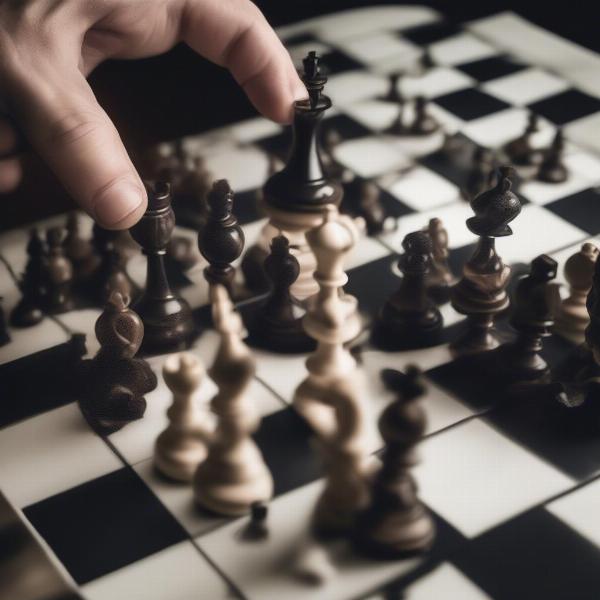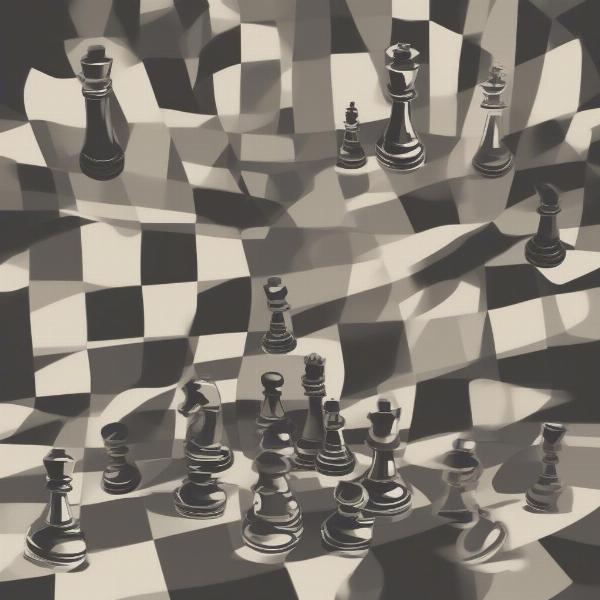Chess, a game of strategy and intellect, captivates players worldwide. Here at supremeduelist.blog, we often explore the nuances of various games, and chess is no exception. Understanding how a chess game can end is crucial for both beginners and seasoned players. It’s more than just checkmate; several scenarios can conclude a match, each with its own implications and strategies. This article will delve into the seven primary ways a chess game can conclude, offering insights into each outcome.
A chess game’s end isn’t always about a dramatic checkmate. Sometimes it’s about strategic resignations or even a draw resulting from stalemate. Mastering these endings is key to becoming a well-rounded player, and this knowledge can dramatically improve your game by anticipating possible outcomes. Let’s explore the diverse ways a chess game can reach its conclusion, giving you a comprehensive understanding of this classic game.
Checkmate: The Decisive Victory
Checkmate is the most well-known and sought-after way to end a chess game. It occurs when a player’s king is under immediate attack (in “check”) and there is no legal move to remove the king from attack. It’s a decisive win for the player who delivers the checkmate. It represents a culmination of strategic maneuvering and tactical execution. To achieve a checkmate, players often need to coordinate multiple pieces and anticipate their opponent’s defensive moves.
What Constitutes a Checkmate?
A checkmate requires three key conditions: the king is in check, no piece can block the check, and the king cannot move to a safe square. Understanding these conditions is crucial to recognizing and executing checkmates. A classic example is a back-rank checkmate where the rook and queen attack the king on the back rank with pawns blocking the escape squares. It is the ultimate goal for most players, and a beautifully executed checkmate can be a source of great satisfaction.
Resignation: Recognizing Defeat
 chess player resigning game
chess player resigning game
Sometimes, a player faces an inevitable loss, and continuing the game would be a waste of time. Resignation occurs when a player concedes defeat, usually when they see that they are in a hopeless situation. This could be due to material disadvantage, a strategically compromised position, or the looming threat of checkmate. Resigning is considered a sign of sportsmanship and practical play, indicating an awareness of when the game is lost. It’s better to accept a loss gracefully than to drag out a hopeless game.
When Should a Player Resign?
Determining when to resign depends on the player’s skill level and the position on the board. Novices may hold on for too long hoping for a blunder, while advanced players may resign when the chances of winning are statistically low. If the opponent has a huge material advantage and a powerful attack, resigning would be a smart move. Knowing when to concede is as important as knowing when to attack, a skill developed through experience and analysis. Similar to the strategic gameplay seen in games can be used as reinforcers for social skills instruction, knowing when to admit defeat is essential.
Draw by Stalemate: A Tricky Outcome
A draw by stalemate is one of the more peculiar ways a chess game can end. This occurs when the player whose turn it is to move has no legal moves to make, but their king is not in check. The game immediately ends in a draw. This often occurs when a player is in a very constricted position, typically at the edges of the board with little or no mobility. Stalemate is a valuable strategic concept that can help to save a losing position by forcing a draw, and it teaches the importance of not cornering your opponents.
How to Avoid Stalemate
To avoid a stalemate, players should always consider the position of the opponent’s king and the mobility of their own pieces. Often it occurs when one player has a large material advantage but does not have enough space to deliver a checkmate, allowing an otherwise losing game to end in a draw. Understanding stalemate is important both to avoid accidentally stalemating the opponent and also to find opportunities to force a draw in an otherwise lost position.
Draw by Agreement: A Mutual Decision
A draw by agreement occurs when both players mutually decide to end the game in a draw. This often happens when neither player has a clear advantage, or both players are comfortable with a draw. Unlike vivica fox two can play that game, which focuses on outmaneuvering an opponent, a draw by agreement demonstrates that sometimes, a mutual conclusion is the best approach. This type of draw can occur at any point in the game and reflects the strategic judgment of both players.
When is a Draw by Agreement Common?
Draws by agreement are common in high-level play when players evaluate the position as balanced and are content with a draw rather than risking a loss. It often saves both players time and effort without compromising their rating or position in a tournament. It also prevents drawn out or boring gameplay if the outcome is inevitable. The ability to recognize a balanced position is key to using this rule effectively.
Draw by Repetition: The Threefold Repetition Rule
 chess board with repeating moves
chess board with repeating moves
The threefold repetition rule is a way a draw can be claimed when the same position on the board occurs three times. This does not mean that the same moves have been made three times, but the same arrangement of pieces and the same player’s turn to move must have occurred at least three times for this rule to apply. It’s a useful tool to prevent a game from dragging on endlessly, and it can be a strategic tool used in both attack and defense, similar to the mind games used in two can play that game movie quotes.
How to Claim a Draw by Repetition
To claim a draw by repetition, players need to keep track of the game’s history and recognize when a position has occurred three times. This can require some diligent note keeping, and it prevents players from continually moving pieces without making any progress in the game. The repetition rule ensures that chess matches are not bogged down with meaningless repetition and promotes active engagement.
Draw by Insufficient Material: Not Enough Pieces
A draw can also be claimed when neither player has enough material to deliver checkmate. This usually occurs in the endgame when the board has been stripped down. This is a fundamental chess rule, and prevents games from dragging on when a win is no longer possible for either side. Common examples include King versus King, King and Bishop versus King, or King and Knight versus King.
What Constitutes Insufficient Material?
Insufficient material can vary, but the main idea is that no force can checkmate the opposing king. This rule ensures the game cannot be won, and thus ends in a draw, allowing players to move on. A deep understanding of the endgame is needed to understand how often this particular situation can arise.
Time Out: Running Out of Time
In timed chess games, a game can be lost if a player runs out of time on their clock. The rules on this can vary depending on tournament regulations or house rules if you are playing informally, but typically, this results in the loss of the game. It is important to manage time effectively in games with clocks. Time management is a skill unto itself, alongside the strategic and tactical thinking required for gameplay.
How to Manage Time Effectively
Time management is critical in competitive chess, and many chess players will find themselves losing due to time control issues. Managing time effectively involves calculating the depth of each move, using time wisely, and having a good understanding of the game’s pacing. In competitive play, this is an extremely common way a game can end, often with either player losing or winning on the clock. You might find this somewhat analogous to the high stakes of the how low can you go game, but the consequences are definitely lower if you lose on the clock compared to a physical challenge.
“Understanding the different ways a chess game can end is paramount to becoming a well-rounded player,” says Dr. Anya Sharma, a renowned chess grandmaster and analyst. “Each outcome requires strategic thinking and careful consideration.”
“Chess is more than just about delivering checkmate,” adds Professor Ben Carter, a leading chess instructor. “It’s about understanding when a draw is the best possible result and recognizing when defeat is inevitable.”
In conclusion, a chess game can end in more ways than just the classic checkmate. From resignations and stalemates to the nuanced rules of repetition and time control, these various endings add depth and complexity to the game. Being aware of these seven ways a chess game can end, allows players to better strategize, anticipate outcomes, and ultimately improve their overall chess skills. Keep learning and exploring the world of chess here at supremeduelist.blog, where we delve into the heart of games and strategic thinking. What will your next move be?
Leave a Reply